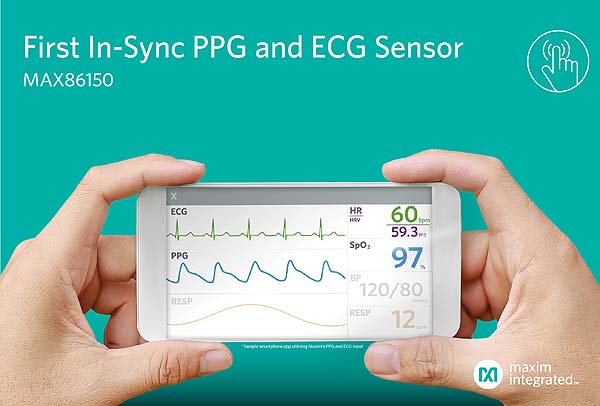 Designers now have an easier way to deliver both photoplethysmogram (PPG) and electrocardiogram (ECG) measurements for health monitoring from a mobile, battery-powered device. The new MAX86150 from Maxim Integrated Products, Inc. is a first-of-a kind biosensor module, comprised of internal LEDs, photodetectors and an ECG analog front-end (AFE) to provide highly accurate, FDA-certifiable PPG and ECG performance in compact, power-saving designs, including mobile phones, laptops, tablets and smart speakers.
Designers now have an easier way to deliver both photoplethysmogram (PPG) and electrocardiogram (ECG) measurements for health monitoring from a mobile, battery-powered device. The new MAX86150 from Maxim Integrated Products, Inc. is a first-of-a kind biosensor module, comprised of internal LEDs, photodetectors and an ECG analog front-end (AFE) to provide highly accurate, FDA-certifiable PPG and ECG performance in compact, power-saving designs, including mobile phones, laptops, tablets and smart speakers.
Delivering synchronized PPG and ECG measurements has been challenging because designers have had to utilize two separate biosensors that together consume more board space and power than a mobile device can typically afford. In addition, achieving high accuracy in the measurements has also been challenging, particularly in cases where sensor sensitivity might be impacted by low perfusion levels or dry skin. The MAX86150 overcomes these challenges, sampling both PPG and ECG simultaneously to provide the highest sensitivity of pulse transit time. To reduce battery drain, the module can be shut down through software with near-zero standby current, allowing the power rails to remain powered at all times. The MAX86150 is available in a 3.3mm × 6.6mm × 1.3mm, 22-pin optical module.
Key Advantages
- Highly Accurate: at 136dB, the module’s common mode rejection ratio (CMRR), a measurement of noise rejection, is the highest on the market. Its 100mA-capable, high-dynamic-range LED driver enables higher sensitivity on an array of skin types. A low-impedance contact for the ECG sensor enables more accurate measurements, even in cases of dry skin.
- Long Battery Life: minimizes battery drain with ultra-low shutdown current of 0.7µA typical. Power consumption less than the closest competitive device further extends battery life compared to competitive solutions.
- Ease of Deployment: its dry electrode operation eliminates the need for gels, fluids and sticky or wet pads on other parts of the body to obtain accurate readings.
- Small Form Factor: the same size as a stand-alone ECG sensor, integrating an ECG sensor with an optical PPG sensor saves space and provides much more functionality without requiring a third electrode (which competitive solutions require).
Commentary
“At-home healthcare monitoring contributed to a 35% reduction in hospital visits in 2017. With access to integrated cardio health monitoring from their fingertips, users will be able to keep close tabs on their well-being.” – Global Industry Analysts, Inc.
“The MAX86150 is another important breakthrough at Maxim, continuing the company’s push to enable a healthier world. With highly accurate heart-rate measurements from a compact, low-power device, consumers will be empowered to be more proactive about their healthcare,” said Mohammad Zarghami, executive business manager, Industrial & Healthcare Business Unit at Maxim Integrated.
Maxim Integrated | www.maximintegrated.com


